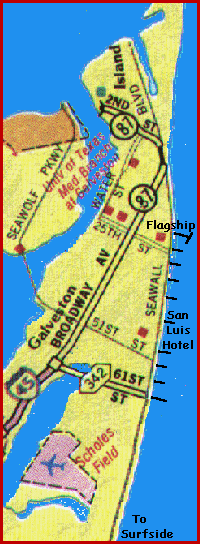 The Galveston Seawall - from 61st Street to the Flagship Pier -
gives the surfer a chance to ride varying wave conditions. Surfing
Galveston is more than just grabbing the first empty parking spot you
see. Seasoned surfers
always cruise the area, looking for the best breaking rock groin.
Seawall surf can range from small, blown out chop, to thick long walls
breaking hundreds of yards past the end of the groins. Since rebuilding
the beach
about '94, the surf mostly breaks outside the rock groins.
However the rocks hold the sand, and on a good swell,
there's usually a hard, dumping wave breaking right at the
end of many of the outcroppings. Paddling
out in the rip next to the rocks is an added plus.
The Galveston Seawall - from 61st Street to the Flagship Pier -
gives the surfer a chance to ride varying wave conditions. Surfing
Galveston is more than just grabbing the first empty parking spot you
see. Seasoned surfers
always cruise the area, looking for the best breaking rock groin.
Seawall surf can range from small, blown out chop, to thick long walls
breaking hundreds of yards past the end of the groins. Since rebuilding
the beach
about '94, the surf mostly breaks outside the rock groins.
However the rocks hold the sand, and on a good swell,
there's usually a hard, dumping wave breaking right at the
end of many of the outcroppings. Paddling
out in the rip next to the rocks is an added plus. Seawall Surf varies with the swell direction, size, and location. The Flagship Pier offers a long right and left peaks off the "T-Head" on a big swell. Paddle out thru the deep channel under the pier. 37th Street can provide a steep, ledgy left on the same swell. Farther down by the San Luis Hotel you'll find slower beachbreak waves. 61st Street has good out side take off at the pier and a powerful inside jetty-protected bowl. That offers protection from strong sidecurrents that may accompany a large swell. All these offer good surfing waves, but are subject to change with the daily tides, or sandbar movement.
Then comes miles of definitionless beach break (Pirates, etc) until your get to San Luis Pass. Here all of Galveston Bay empties out in a pass less than a half mile wide. The sand piles up and so the waves break pretty far out, but on big swells a few push down the channel. While there are some good looking waves on occasion on either the left or right side, the place has two major problems: a death current and large and numerous sharks. On the wrong tide conditions even a power boat can't fight the current. Many DEATHS have been recorded here; drowning happens.